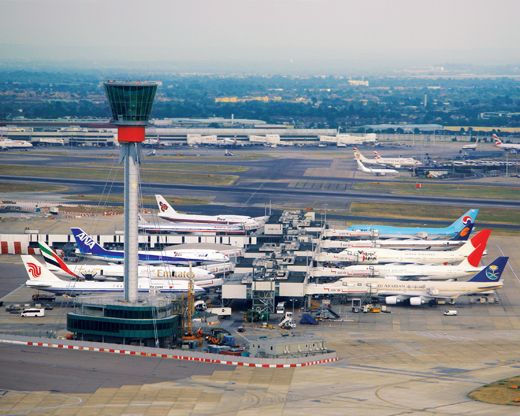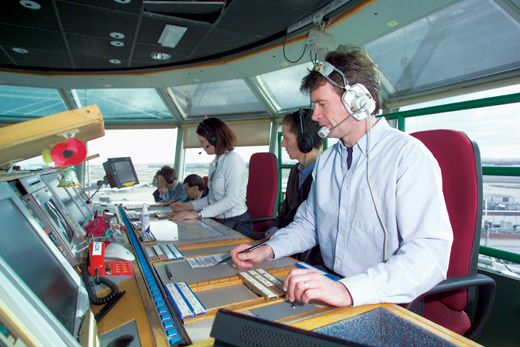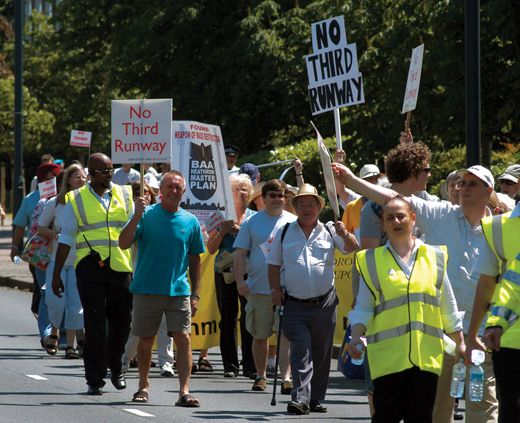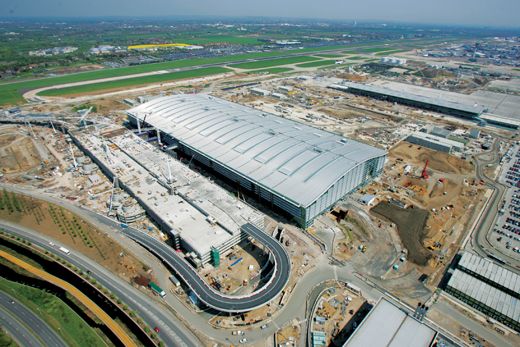475,000 Takeoffs and Landings a Year
The Summer Games will bring 4,000 additional aircraft to London’s airports. Find out what it takes to keep Heathrow running smoothly on a normal day.
/https://tf-cmsv2-smithsonianmag-media.s3.amazonaws.com/filer/heathrow_631-jan07.jpg)
Seconds after a British Airways Boeing 747 touches down with a puff of burning rubber, Pete Wooldridge and Jim Davison pull onto one of two runways at London’s Heathrow International Airport in a yellow and orange sport utility vehicle. Their job is to inspect the pavement for debris, cracks, or anything else that could perturb a jet traveling at 100 mph. But as they cruise down the centerline, it’s tough to ignore the view through their windshield: five airliners lined up on approach, all speeding straight at them.
Then the control tower radios orders: Vacate the runway. Wooldridge hits the gas and twists the wheel like he’s dodging a semi. The SUV lurches off the pavement at about 50 mph and jounces across the grassy shoulder as the tires of a Jet Airways Airbus A340-300 from India slam onto the runway, the airliner thundering past.
This is life at Europe’s busiest international airport, where the twin runways are some of the hardest working expanses of concrete on Earth. No other major airport moves so many airplanes and passengers through so little space, with so little time to spare. Any holdup reverberates around the world. Competition for landing rights is so fierce it’s the crux of international treaty negotiations (see “Finding a Place to Land,” p. 49).
But the cramped and crowded airport is in a battle for its future. Paris, Amsterdam, and other European airports boast more runways and space to handle the rising demand for air travel. Their flight schedules are growing while Heathrow is maxed out, hemmed in by residential areas and neighbors complaining noisily about noise.
The government’s response to the overcrowding is to float plans for giving Heathrow another runway, which would mean bulldozing centuries-old English villages off the map. People from surrounding villages promise, quite matter-of-factly, that before this happens, they will paralyze the airport with protests and lie in front of bulldozers. It has become, for Londoners, a kind of referendum on the future of commercial aviation: Unfurl new runways for an ever-expanding stream of global jet traffic that now has Heathrow bursting at the seams, or lay down limits on how far it can grow.
“The airport was a friendly employer years ago,” says Bryan Sobey, who started work at Heathrow as a young customs officer when the aircraft parked at the gates were Boeing Stratocruisers and Lockheed Constellations. He retired as a manager 15 years ago, and lives with his wife, Ann, in a working-class rowhouse just north of the airport. The windows are triple-paned and the walls lined with Styrofoam panels to mute airplane noise. His cluttered living room, with paintings of trains, bowling trophies on the walls, and cards celebrating the couple’s 55th wedding anniversary, sits where check-in desks and shops are to be located in a new terminal for the planned runway. Today, Sobey says, Heathrow is “like a dragon breaking out of its egg. It’s become an object of threat, really.”
RAF Heathrow
The airport began amid shady maneuverings near the close of World War II, when Winston Churchill’s government used wartime powers to seize a small private aerodrome and a village called Heath Row for a Royal Air Force base to supply troops in the Far East. But Harold Balfour, Churchill’s undersecretary of state for air, later admitted that was only a ploy to get control of the prime land, 12 miles west of Victoria Station, for London’s main commercial airport.
No base ever appeared. But Heathrow airport did.
This put what would turn into the world’s most bustling international airport smack in densely populated West London, the first of what two top British planners called “a series of minor planning disasters that together make up one of the country’s truly great planning catastrophes.” An early scheme would have permitted the airport to grow by adding more runways to the north, the same location where the unpopular new runway is now proposed to go. But funds ran short, and in 1952 the scheme was dropped. Airport neighbors sighed with relief, and construction began on houses like Bryan Sobey’s.
So the airport grew without much of a plan at all. When flying became more affordable in the 1970s—round-trip tickets between London and New York in the 1950s cost more than $4,000 in today’s dollars—terminals popped up one by one, crammed between a nexus of runways and taxiways originally built in a Star of David pattern. The cheaper and more popular air travel became, the more Heathrow grew; new concourses inched like tentacles from the airport’s center onto the taxiways and runways. Eventually, they left only two parallel east-west runways that today send airplanes over the most populous parts of Europe’s second largest city.
The Air Traffic Two-Step
A 1978 government report estimated Heathrow’s capacity at 275,000 takeoffs and landings a year. Today, it manages about 475,000. The runways handle 1,370 takeoffs and landings in a day—up from 1,290 in 1995—all with no new pavement. They haven’t been widened or lengthened. But controllers have found ways to squeeze more aircraft onto them.
Air traffic controllers pride themselves on each week’s takeoff and landing stats—with number of minutes’ delay—which are displayed on a scoreboard-style readout in the air traffic center’s lobby. Martyn Jeffery recalls Heathrow’s record like a proud father. He is Heathrow’s general manager for National Air Traffic Services, once a government agency but now a private company that manages air traffic. The date was September 22, 2005: 48 arrivals and 52 departures in an hour—slightly less than one a minute.
Heathrow has gone 34 years without a major accident. The last was a British European Airways Trident that crashed just after takeoff in 1972, killing all 118 aboard. It was the nation’s worst air disaster—that is, until the bombing of a Pan Am 747 over Lockerbie, Scotland, in 1988. Collisions have happened—on the ground. At least three times since 2004, airplanes jostling for position on busy taxiways have bumped wings or rudders. In 2005, the crew of a United Airlines 777 that struck an Air Jamaica A340 while heading for a takeoff holding spot suggested the Airbus was closer than it would be at other airports. But investigators said, “This was not considered unusual for Heathrow.”
One of the trade secrets of Heathrow’s air traffic controllers is that they don’t think about the people. They focus on the airplanes, because considering the hundreds inside every one—sipping their complementary sodas and worrying about their connections—would rapidly overwhelm anyone, says Mark Hewitt, a control tower supervisor.
A trick to making the most of Heathrow’s runways comes clear in the routing of inbound airliners. They go first to one of four beacons at each corner of the airport, where they circle in stacks—each one 1,000 feet above the other—waiting for controllers to direct them in. For passengers, it’s frustrating. For controllers, the stacks supply a constant reservoir of airplanes to put—rapid-fire—onto the pavement. The steady stream of airplanes from the stacks guarantees the runways never go idle.
Heathrow’s schedule is so full that if the runways stand empty for even a moment, millions of dollars’ worth of landing time will be lost.
“Once it’s gone, it’s gone, and you’ll have a delay through the rest of the day that you cannot recover from very easily,” says Martin Alder, a former air traffic controller and pilot who recently retired from flying British Airways 747s and A320s in and out of Heathrow. “The only way it can work to the levels it does is uniformity.”
The stacks also give controllers a choice of airplanes. A big 747 trails powerful tornado-like vortices from its wings, so a smaller Airbus A321 cannot follow as closely. Faster airplanes catch up to slower ones. Airliners flying against the wind touch down at a lower speed so they can turn off the runway faster. Controllers deal a landing lineup out of the stacks based on all these factors, packing airplanes as close as safely possible.
The dealing is done deep within a dull concrete building a few miles north of Heathrow, in a room the size of a small gymnasium, called the London Terminal Control Centre. Controllers at screens along both sides of the room watch over some of the most congested airspace on the globe, handling all airplanes below 24,500 feet flying to and from Heathrow and domestic airports Gatwick, Stansted, Luton, and London City. Today Andrew Garrett has one of the hottest seats in the room. He is the Heathrow director, guiding much of that airport’s incoming traffic.
Right now, his green-glowing screen shows problems: The northern stack, which collects airplanes from Central Europe, has turned into a snarl as pilots wheel around thunderstorms.
The landing rate has dropped from the usual goal of 45 airplanes an hour to about 35, troubling Garrett like too few RBIs would a cleanup hitter. Instead of three miles apart, airplanes entering the stack are about four miles apart, which to Garrett means wasted time. It also means airplanes showing up from around the world stack up faster; monitors in the center of the room show how many minutes each one is behind its estimated time of arrival.
He spots an Alitalia flight from Milan and sees a chance to shave off some time. It’s bound for a southern stack, but he intercepts it. Telling the pilot to turn right, Garrett weaves the Airbus A321 between two other aircraft sliding across his screen toward the runway. That puts one more airplane on the pavement this hour.
Up in the Heathrow control tower, controllers—some in their 20s and wearing T-shirts—sort everything out onto the pavement. The tower takes over flights four miles from the airport. By that point, the airplanes are on final approach, as set up by London Terminal Control Centre, so the tower controllers shouldn’t have that much to do with the aircraft aside from instructing inbound flights to adjust speed to maintain minimum spacing and keeping an eye on potential missed approaches.
Two ground controllers—airport traffic cops—weave 747s between and among A330s. Multi-lateration radar triangulates on each airplane’s transponder signal, showing each as a radar dot while still on the ground—even behind buildings. It helps controllers work them out of dead-end cul-de-sacs amid terminals built for small airplanes like Hawker-Siddeley Tridents but quickly clogged by modern airliners twice as wide.
A jumbo pulling out may gridlock other airplanes for five minutes or more, and start blocking taxiways. Controllers know almost every patch of spare tarmac where they can put airplanes to sit and wait, but, says Phil Layton, Heathrow’s air traffic control manager, “There’s less and less places for us to hide them.”
A fourth terminal was built on the far side of the southern runway when space ran out in the airport center; to reach it, airplanes must scoot across the runway between the takeoffs and landings of others.
Moving airplanes gets easier at night, when controllers use a touch screen to turn on lights in the runways. Controllers tell pilots to “follow the greens,” illuminating a line of green lights along the right path. Red lights across the taxiway mean “stop.”
The time between each takeoff is known as a “Heathrow minute,” and in the tower, the goal is to shave it to the bare minimum. Jetliners take off as close as a minute apart, as long as they follow different routes so there is no risk of one catching the other. Controllers shrink the minute even further by craning their necks and watching for an airplane’s wheels to lift off the pavement. That’s when the next aircraft goes.
“At Heathrow, we call that a minute,” says Paul Hooper, a tower supervisor. Then he grins. “Depending on the airplane, it’s probably a bit less than a minute.”
It is the most critical timeline at Heathrow. There is a constant campaign to keep pilots from dawdling on the runway; if each airplane throughout the day wastes a few seconds, it adds up to a few airplanes getting stuck when the nighttime flight curfew shuts down nearly all operations. Stephen Mathewson, a former engineering professor who got bored by academic life and joined airport owner BAA as an internal consultant, went to great lengths to measure how fast pilots get on and off the runway. He posted traffic police at the end of the pavement with radar guns to clock the speed of each airplane. Later he turned to ground radar to track each pilot’s habits.
Then he crunched the numbers and showed each airline how its pilots were doing. Soon, slowpokes picked up their pace. Virgin Atlantic worked timing into its simulator training. Pilots set their brakes to make better use of high-speed runway exits, which are angled so airplanes can turn off at 50 mph. That adjustment shunts them out of the way faster—arrivals average 50 seconds on the runway. No one wants an airplane poking along, sitting in the way, or braking too late, missing its turn, trundling to the next exit—a time-waster.
“Most professionals want to behave ably,” says Mathewson, who finds himself part efficiency analyst and part psychologist. “You don’t need to force them. You just need to raise their awareness that this is an issue, and they can help.”
The airport spent about a half-million dollars building a temporary exit next to one closed for eight weeks of reconstruction. Otherwise airplanes would have had to coast 500 feet farther down the runway before turning off, which would slow the landing rate.
“This is the business of teasing the edges,” says Richard Smith, a lanky, intense man who helps plan the future of the airfield. He likens Heathrow to a giant aircraft carrier. When he started, after getting turned down for pilot training nearly 30 years ago, 900 airplanes were taking off and landing every day; now 1,370 do. He knows the angle of each taxiway, which affects which way airplanes can turn, which in turn affects how long they take to reach the gates. He knows which airplanes fit at which gates, and how juggling gates at the last second sends ground crews dashing through the airport.
In certain places, 747s park nose-out so their tails do not block signals from the instrument landing system. Workers are tearing down a few gates so the new double-deck A380, the world’s largest passenger airplane, has room to pass (see “Superduperjumbo,” June/July 2006). The airport is counting on the airplane to pack in more passengers. But air traffic controllers are starting to scream about all the construction.
“They have said to us, ‘We’re getting to the point we can’t maintain the movement rate, not because we can’t use the runway, but because we don’t have the taxiways,’ ” says Smith, racing around the airport in a white car with a flashing light on top. He eyes a taxiway that is a quilt of concrete patches. “The problem is keeping Heathrow going under all this pressure. We spend huge amounts of time and effort making sure this place doesn’t fall over, and it doesn’t happen by chance. It works because the place collectively works as a team, by design or by default. And it’s not all by design.”
An American airliner appears in the rear-view mirror: “I’ve got to keep an eye on that one,” Smith says. “I don’t want to get run over by a triple-7.” Computers match airplanes to gates, he says, but it’s not a simple process: Arab aircraft cannot be parked next to Israeli ones, for example.
Then he sees airplanes parked in a lineup of gates that causes him to chortle: American Airlines 777, United Airlines 777, American 777, United 777, and Iran Air 747. “Well, gee, Mr. Bush! Clearly one of the parameters in the computer is it’s okay to put the Iranians next to the Yanks,” Smith cackles. “I think that’s quite funny.”
On any given day, tomorrow at Heathrow has already started. Airplanes are on their way from Hong Kong and beyond, for an arrival the next morning. “Airlines have been told to slow up miles out because there’s no use getting here early if we have no bloody place to put them,” Smith says. It’s practical, and, as far as the passengers are concerned, “Will you notice if the airplane slows down 15 knots, or will you notice sitting on the ground for 20 minutes with the engines running?”
Once the airplanes have landed, Ian Watson juggles them, finding them places at one of Heathrow’s roughly 165 gates. The computer may plan out the day, but it can’t account for glitches—jetways break, airplanes are late, the weather is unpredictable. So Watson takes over where the computer leaves off, compensating for the unexpected. He works in a bunker-like building in the crook of two taxiways. The building would have a great view of passing airplanes if not for computer screens that block all the windows. Watson uses a joystick to scan every nook of the airport, working out which airplanes get to park at a gate, or pier. Since Heathrow has more airplanes than gates, some park out on the pavement and wait for buses to ferry passengers to terminals.
Neighborhood Relations
About a mile and a half from the end of Heathrow’s southern runway is the Hounslow Heath Infant School, a public preschool where cheery Kathryn Harper-Quinn is the head teacher. She loves airplanes. The sleek Concorde, which rocketed in and out of Heathrow until 2003, was “one of the most beautiful things I’ve ever seen,” she says. But the everyday aircraft, descending over the school at slightly less than one per minute, cost teachers roughly 10 seconds out of every minute of classroom time. Everybody stops talking because the noise drowns out anything they say.
“You have to time the ringing of the bell,” she says one summer morning. “If you ring it when an airplane goes over, nobody hears it.” The whirlwind-like vortex from a passing airplane shattered tiles on the roof of the school’s kitchen. Sometimes vortices suck the shingles off roofs like a vacuum. Heathrow confirmed 102 “vortex strikes” on nearby buildings in the last fiscal year. Whenever this happens, the airport sends workers out to the damaged properties to fasten each shingle down with metal clips.
While airplanes have grown quieter, the number of flights to and from Heathrow has nearly doubled in the last 25 years—like a shift, locals say, from an occasional truck passing your window to constant traffic.
Noise is loud enough to irritate at least 300,000 people, the government says. Studies in nearby neighborhoods have found the noise impairs schoolchildren’s reading comprehension and memory. In 2001 the European Court of Human Rights ruled that the rights of the airport’s neighbors to peaceful sleep had been violated. The ruling was later reversed, but the airport now offers neighbors up to about $24,000—depending on the value of their home—to move away.
Tension over airport noise, mounting for decades, has brought Heathrow under some of the tightest noise restrictions in the world. Pilots descend toward the airport on a smooth trajectory, rather than dropping in stair steps from one level altitude to the next. In the continuous-descent approach, as it’s known, pilots do not gun the engines to level off along the way, and airplanes remain farther above homes—cutting noise roughly in half. Unlike many U.S. airports, Heathrow is privately owned, and its noise strategies are distinctly free-market. The louder an airplane, the higher its landing fees.
Computers linked to air traffic control radar track each airplane, and pilots who do not follow the rules get a talking-to from airport managers. Microphones at the end of runways track noise, and each airplane that breaks the limits gets fined up to $2,000.
Rules tighten at night, when the noisiest aircraft are banned entirely: Only about 16 airplanes are permitted to land or take off between 11:30 p.m. and 6 a.m., and the noisier they are, the fewer are allowed. Sometimes early airplanes circle in the sky until the curfew lifts.
Manufacturers design airplanes with Heathrow in mind. Airbus worked over the engines and wings of its double-deck A380 to make sure it would meet Heathrow’s noise rules. Boeing guarantees its new 747-800 will fly quietly enough to be allowed in and out of Heathrow at night.
Airliners at Heathrow take off from only one runway while landing on the other, lending a semblance of order to the place. At 3 p.m. each day, they switch—landing on the one they took off from in the morning. It takes air traffic controllers about a half-hour to orchestrate the switch. With some exceptions, depending on the prevailing winds, it gives people living at each end of the runway half a day of relative peace and quiet.
Airport managers and airlines also want to start landing and taking off on both runways at the same time, which would let controllers put airplanes closer together and squeeze more in. They also want that third runway.
Current runway limits push airlines toward more profitable big airplanes that fly greater distances, leaving less runway space for shorter connecting flights. The solution, they say, is a new runway for the smaller airplanes that fly short routes, freeing the main runways for big ones. But that fix means the airport would reach beyond the façade of airport hotels and rental-car lots that surround it to take over towns to the north where “No third runway” signs outnumber flags supporting Britain’s World Cup soccer team.
The British government says the third runway will go forward only if the airplanes get quieter and cleaner—the air around Heathrow now violates European Union air standards—but the mayor of London and city councils around the airport still oppose the expansion. They’re urged on by a coalition of mothers worried their children’s schools will get wiped out and environmentalists who blame air travel for contributing to greenhouse gases in the atmosphere.
The runway would take out about 700 homes and other buildings.
“We’ve lived with the airport,” says Linda McCutcheon. The new runway would replace her home, as well as the house she grew up in, the church she got married in, and the schools her children attended. “We don’t want the airport to go away. We just don’t want it to get bigger. There will just be that many more airplanes. Where will they all go?”
Just Passing Through
Passengers at Heathrow enter an outdated and overtaxed world of parking garages turned into terminals, with ceilings so low that tall people hit their heads, moving walkways that suddenly stop moving, and blue plastic buckets on the floors of busy corridors to catch water dripping from the ceiling. Frank Bowron, a one-time Heathrow employee who travels frequently through the airport, has seen escalators feed so many people into the confines of an international connecting lobby that children had to be passed overhead to keep them out of the crush. Conditions like this would discourage even the most seasonsed travelers, which is why airport managers have a plan.
The future of Heathrow rises on the west end of the airport: a fifth terminal, built atop what used to be a sewage works, with more glass than a cathedral and the space of nearly 10 football fields on each of its five floors. The project includes a new control tower 285 feet high, more than twice as high as the old one. It’s the biggest construction project in Europe, and opens in 2008 with 60 new gates—a quarter of them big enough for the A380. It will ease crowding until about 2011—when the airport is expected to again max out.



